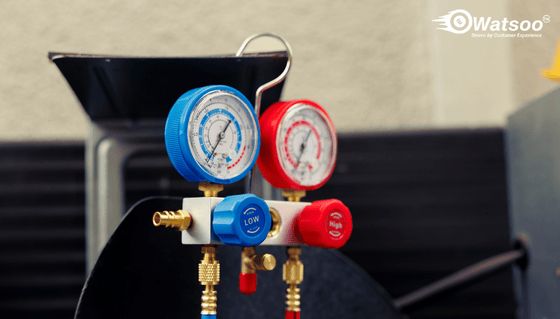In this blog, we have shared our suggestions for you to consider when you choose the best load cell types for your project in 2025.
Table of Contents
ToggleIn today’s advanced world, businesses require accuracy and precision in their industrial automation. Load Cells play a vital role in providing automation for industrial weighing and force solutions. They are used in weighbridges, aerospace testing, and industrial machinery systems.
It is essential to select the appropriate load cell type based on your specific business needs. The blog provides detailed information on all types of load cells and uses 2025. Get a comprehensive overview here that helps you select the most suitable load cell sensor for your project requirements.
Types of Load Cell Overview
Countless load cell types customized according to specific demands are available on the market. Each of them functions to measure a particular force, such as tension, bending, or compression. You should consider the application, force direction, and environment where the load cell will be used. The blog consists of all types of load cells in 2025.
What are Load cells?
A load cell is a force measurement sensor that transforms mechanical energy into electrical energy. Commercial and industrial systems use them for accurate weight management and force calculation. They are essential as they ensure accuracy, efficiency, and safety in the business processing automation and weighing systems. You can find various types of load cells and uses below.
How Does It Work?
Different types of load cell sensors have different working principles and processes. They commonly convert force into an electrical signal. This mechanism varies significantly between hydraulic, pneumatic, and strain gauge load cell types. Generally, a load sensor mechanism used in strain gauge load cell sensors has the following workflow:
- Force Application (Physical force (Pressure, Compression, or Tension) applied to the Load Cell.)
- Strain Gauges Reaction (Load cell material minute deformation, strain gauges are bonded.)
- Electrical Signal Generation (Deformation changes the electrical resistance in the strain gauges.)
- Signal Amplification (Small voltage change transformed to measurable electrical signals.)
- Data Interpretation (Signal calibrated and converted as a weight or force value.)
Types of Load Cells and Uses
From industrial weighing to framework testing, all types of load cells are optimized based on the force direction, precision levels, and environmental conditions. Thus, different load cells cater to different applications. Due to this, it becomes necessary to understand all load cell types.
What are the Types of Load Cells?
The load cells are chiefly divided into 5 types. All types of load cells and uses are specified below. Each of them carries unique features and is used for specific applications.
1. Strain Gauge Load Cell
A strain gauge load cell is a transducer that measures force and transforms it into an electrical signal. This type of load cell is popularly used in modern applications, thanks to its high reliability and accuracy.
It utilizes strain gauges (sensitive to deformation) to detect changes in resistance whenever an external force is applied. These changes are transformed into computable electrical output. This indicates the force magnitude.
Strain Gauge Load Cell USPs:
- Material Deformation Based
- High Accuracy Under Varying Loads
- Popularly used in Weighbridges and Tanks
- Suitable for Static and Dynamic Loads
- Cost-effective and Compact
2. Hydraulic Load Cell
Our load cell types list includes a hydraulic load cell, which is a weight or force sensor. This uses hydraulic pressure to calculate applied loads. It transforms force into pressure change within a limited fluid. This change is measured to discover the applied weight or force.
They are popular for durability, precision, and reliability. This type of load cell is ideal for harsh environments where no electricity is required. It utilizes fluid pressure changes to calculate force.
Hydraulic Load Cell USPs:
- Works without Electricity
- Suitable for Outdoor Areas
- Durable and Resilient
- Less Sensitive than Others
- Non-linear Output (Compared to digital sensors)
3. Pneumatic Load Cell
Our load cell types list includes a pneumatic load cell, a force transducer that utilizes air pressure to measure force or weight. People popularize them for their temperature insensitivity, making them highly suitable for use in clean and secure work surroundings. They measure small weights.
It offers clear, explosion-proof operations appropriate for sensitive environments. It balances an applied force with accurately regulated air pressure, with the final pressure being proportional to the applied force.
Pneumatic Load Cell USPs:
- Highly Secure in Explosive Surroundings
- No Sparking Risk
- Suitable for Food & Pharma Sectors
- Less Accurate than a Strain Gauge
- Requires a Consistent Air Supply
4. Compression Load Cell
Our load cell types list includes compression load cells, transducers that convert weight or force into an electrical signal. They are designed to measure force under compression, common in platform scales and silos. The strain gauges are attached to the body of the load cell.
Under compressive load, the body of these load cells deforms slightly. They measure compressive forces, which are the squash force, applied along a single axis. Most commonly used for measurement & weighing in high-capacity static weight.
Compression Load Cell USPs:
- Downward Force Measured
- Strong Construction
- Ideal for Weighbridges and Tanks
- Handles High Capacity
- Requires Mounting Precision
5. Tension Load Cell
Our load cell types list includes a tension load cell. It is a force sensor developed for measuring tensile forces. These are stretching or pulling forces. These cells are used to measure pulling tension or force in cables, cranes, and hoists.
It transforms the applied tension into an electrical signal. This makes it useful for numerous applications (Industrial Processes, Material Testing, and Structural Monitoring) where the tension measurement is essential.
Tension Load Cell USPs:
- Measures Upward, Pulling Forces
- Suitable for Suspended Weighing
- Used for Material Handling
- Compact with Eye-bolt Ends
- Needs Secure Attachment Points
These are all types of load cells and uses. You can understand and utilize this information while searching for a suitable load cell sensor for your business.
Load Cell Applications
Load cells are used across industries that require accurate force measurement. You can find various types of load cell for Weighbridge system solutions. Some of the key application areas for load cells are:
Weighbridges, Industrial automation, Tank and silo weighing, Crane load monitoring, Force measurement in labs, Medical devices, Aerospace testing, Robotics, Automotive test rigs, and Packaging machines.
Picking the Right Load Cell: What You Need to Know
Selecting appropriate load cell types is crucial for obtaining accurate and reliable measurements across various processes. To choose the best, you should consider accuracy, capacity, mounting options, toughness, and signal compatibility. A load cell ensures precision, durability, and simple integration with measurement systems.
- Choose a precise load cell that calculates the required accuracy.
- Find out the load cell capacity based on the expected maximum force.
- Take environmental factors and chemical exposures into account.
- Select the optimal mounting configuration for your system.
- Ensure compatibility with the data acquisition system and the electrical signal.
Which type of load cell is used in a Weighbridge?
Weighbridges use compression and strain gauge load cells in their process. Their product is the best among all load cell types. This is because of their high capacity, accuracy, and toughness. These load cells are integrated with smart electronics for quick monitoring, data analytics, and remote calibration. Their system offers AI-based data processing and cloud monitoring features
You can opt for the Watsoo Weighbridge Automation System, which provides advanced IoT-enabled load cell sensors. Their weightbridge automation system ensures accurate weighing with no human errors. Enhance your security with this unique solution for industries looking for dependable weight measurement.
Conclusion
Select the right load cell type for your company’s efficiency and reliability; measurement systems are mandatory. From compression to hydraulic, tension to pneumatic, each load cell type serves a unique purpose. Watsoo and other companies offer numerous types of load cell for Weighbridge system solutions.
Calculate your requirements based on your application, required accuracy, and environmental conditions to make the best choice. For business automation, choose smarter, faster, and accurate solutions like Watsoo, the best Indian Load cell sensor manufacturer in India 2025.
FAQs
Q. How many types of load cells are there?
Load cells are primarily divided into 5 types: Strain Gauge, Hydraulic, Pneumatic, Compression, and Tension Load Cell. Each of them serves distinctive environmental conditions and force directions. Load cell types are divided based on their implementation and use.
Q. What is the purpose of a load cell?
The purpose of any load cell is to accurately measure the weight or force and transform it into readable electrical signals. They ensure efficiency, security, and accuracy in automation and weighing systems. The purpose of the types of load cell for Weighbridge system solutions is logistics and transportation services.
Q. What is the working principle of a load cell?
Based on its type, load cells work on different principles. Strain Gauge load cells use deformation and resistance change. Pneumatic load cells use compressed air and balancing pressure. All of them commonly convert the mechanical force into pressure signals or electrical force for precise measurement.
Q. What are the advantages of load cells?
The load cell sensors offer high measurement precision, numerous application solutions, compatibility with automation systems, durability, reliability, digital calibration, and much more for industrial processes. Various load cell types require minimal maintenance, are easy to integrate, and can work in tough environmental conditions.
Q. What is the difference between a static and a dynamic load cell?
A static load cell measures the constant, unchanging loads, such as Tank weighing, whereas a dynamic load cell captures quickly changing forces, such as crash testing. The choice depends on the application requirement, whether steady or varying.


